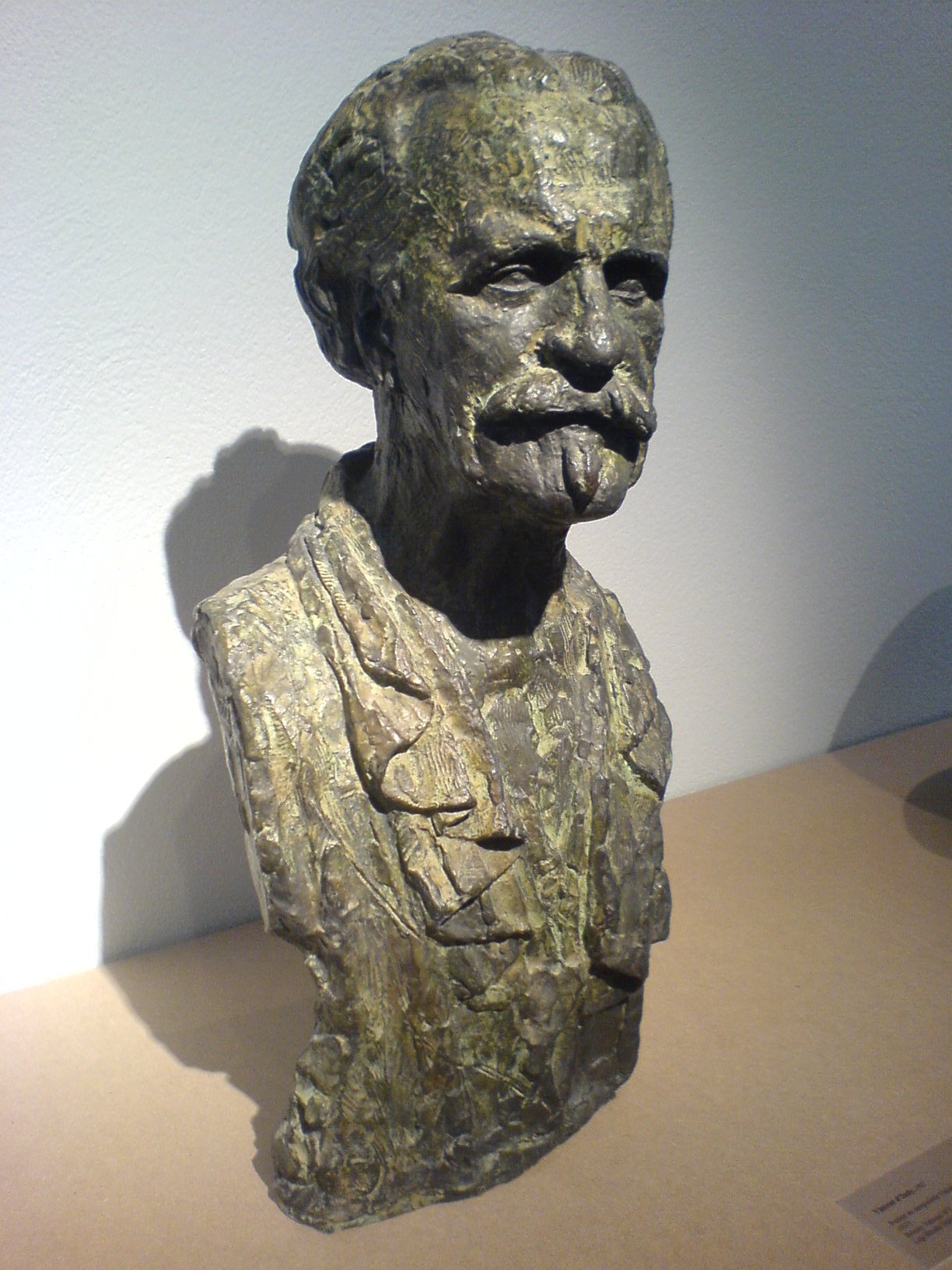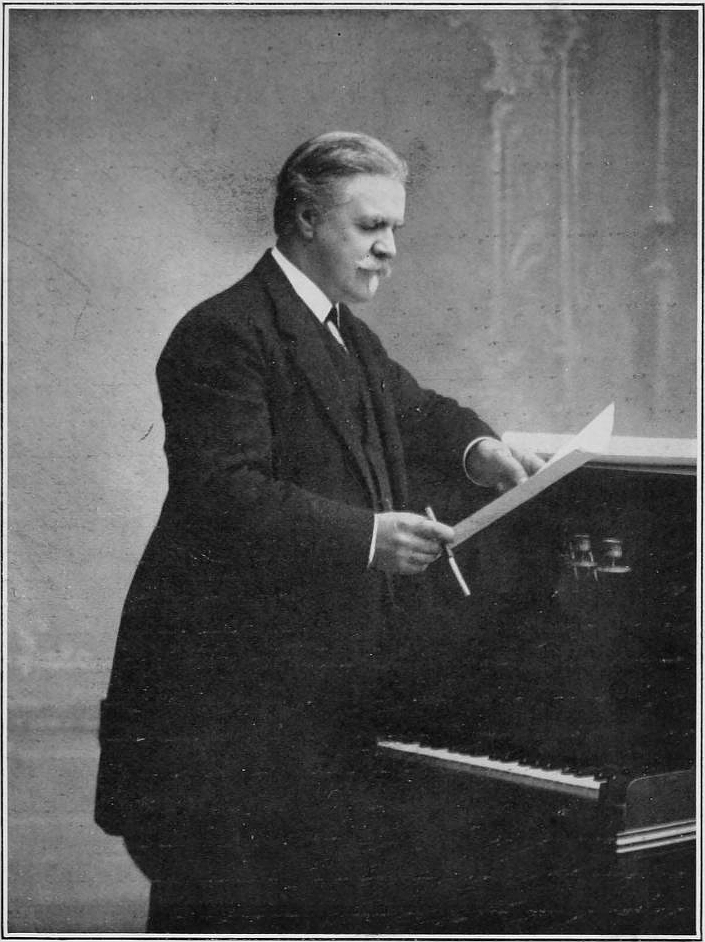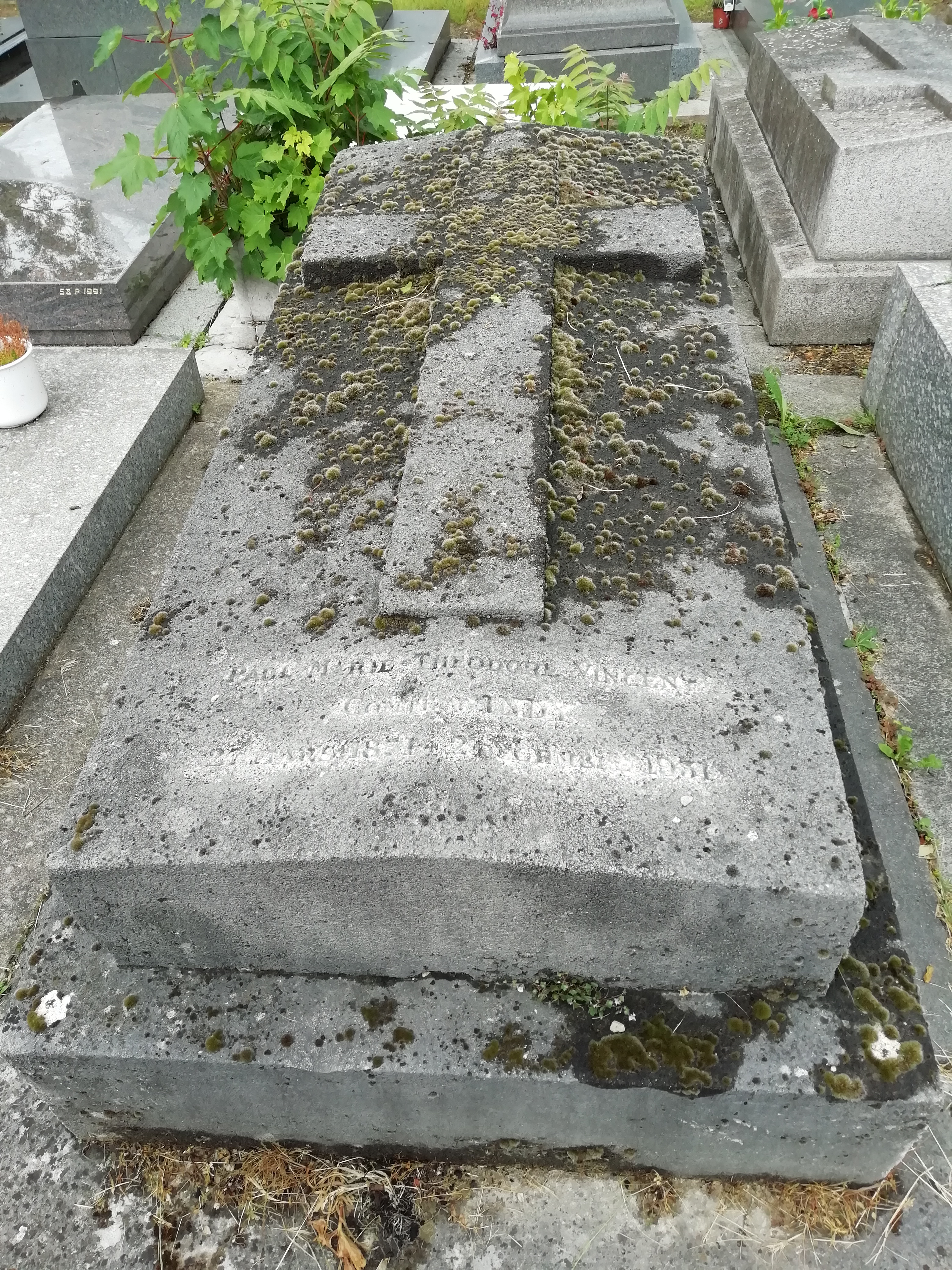1. Early life and education
Vincent d'Indy's early life was shaped by an aristocratic family background and a formal musical education that laid the foundation for his distinguished career.
1.1. Family background and childhood
Paul Marie Théodore Vincent d'Indy was born in Paris, France, on March 27, 1851. He hailed from an old, aristocratic family in the Ardèche region of southern France, known for its royalist and Catholic convictions. His great-grandfather was the politician Joseph Isaïe Saint-Ange d'Indy.
1.2. Early musical training
From a young age, d'Indy received piano lessons, initially from his paternal grandmother. She later arranged for him to study with renowned teachers such as Antoine François Marmontel and Louis Diémer. By the age of 14, he began studying harmony with Albert Lavignac. At 16, an uncle introduced him to Hector Berlioz's treatise on orchestration, which ignited his passion for composition. He composed a piano quartet, which he sent to César Franck, who recognized his talent and encouraged him to pursue a career as a composer.
1.3. Paris Conservatoire and César Franck
During the Franco-Prussian War, d'Indy enlisted in the National Guard at the age of 19. Upon returning to civilian life after the hostilities ceased, he enrolled in the Conservatoire de Paris in 1871, joining Franck's organ class. He remained at the Conservatoire until 1875, studying not only organ but also composition under Franck. In 1875, he earned a first prize in organ. Franck's mentorship proved profoundly influential, particularly his admiration for German music, which instilled in d'Indy a deep appreciation for the German tradition.
2. Early career and rise
After completing his formal education, d'Indy embarked on a multifaceted musical career, marked by practical experience, significant encounters with leading European musicians, and the composition of his first major works.
2.1. Franco-Prussian War and initial musical activities
Following his military service in the Franco-Prussian War, d'Indy immersed himself in the musical world. To gain practical experience, he joined the percussion section of the orchestra at the Châtelet Theatre in 1875. He also served as the chorus-master for the Concerts Colonne from 1875 to 1879.
2.2. Encounter with German music and Wagner
D'Indy's musical development was significantly shaped by his exposure to German music. In the summer of 1873, he visited Germany, where he met prominent figures such as Franz Liszt and Johannes Brahms. A pivotal moment occurred in 1876 when he attended the first production of Richard Wagner's Der Ring des Nibelungen (The Ring Cycle) at the Bayreuth Festival. This experience left a profound impression on him, transforming him into a fervent Wagnerian. He later heard Wagner's Parsifal in 1882. Despite this strong influence, d'Indy also expressed reservations about what he perceived as the "grandiloquent hysteria" of Wagner's heroes, striving for Christian love and sublime simplicity as underlying themes in his own operas.
2.3. First major compositions
D'Indy's early career saw the premieres of several important compositions that established his reputation as a promising composer. The first of his works he heard performed was a Symphonie italienne (Italian Symphony), which was admired by contemporary composers Georges Bizet and Jules Massenet. On January 25, 1874, his overture Les Piccolomini was performed at a Jules Pasdeloup concert, notably programmed between works by Johann Sebastian Bach and Ludwig van Beethoven. In 1875, his symphony dedicated to János Hunyadi was performed. That same year, he played a minor role as a prompter at the premiere of Bizet's opera Carmen. His symphonic ballad La Forêt enchantée (The Enchanted Forest) premiered in 1878. This was followed by the choral work Le Chant de la cloche (The Song of the Bell) in 1883, which won a music prize in Paris, and the symphonic poem Saugefleurie (Sageflower) in 1884. His piano suite, referred to as a "symphonic poem for piano," titled Poème des montagnes (Poem of the Mountains), also originated around this period. In 1887, his Suite in D for trumpet, two flutes, and string quartet appeared. He was also involved as choirmaster in Lamoureux's 1887 production of Wagner's Lohengrin. His music drama Fervaal occupied him between 1889 and 1895.

3. Pedagogical activities and institutions
Vincent d'Indy made substantial contributions to music education, most notably through the establishment of the Schola Cantorum de Paris and his influence on the Société Nationale de Musique.
3.1. Founding of Schola Cantorum de Paris
Inspired by his studies with César Franck and dissatisfied with the prevailing standards of teaching at the Conservatoire de Paris, d'Indy co-founded the Schola Cantorum de Paris in 1894. His collaborators in this endeavor were Charles Bordes and Alexandre Guilmant. Initially, the institution focused on teaching and researching church music, reflecting a concern for the decline of sacred music traditions. From 1900, the Schola Cantorum expanded its scope to become a general music teaching institution, where d'Indy taught until his death.
3.2. Principal and teaching philosophy
D'Indy assumed the role of principal of the Schola Cantorum in 1904. His teaching philosophy emphasized a solid grounding in technique, rather than prioritizing originality above all else. This approach, while fostering strong fundamental skills, led to observations that few graduates could compare with the most innovative students from the Conservatoire. His comprehensive theoretical work, Cours de composition musicale (Course of Musical Composition), a three-volume treatise, was based on his lectures at the Schola Cantorum and became a significant text in music theory. D'Indy also taught at the Conservatoire and privately, while maintaining his position at the Schola Cantorum.

3.3. Influence on Société Nationale de Musique
D'Indy played a crucial role in the history of the Société nationale de musique (National Society of Music), of which his teacher, Franck, was a founding member in 1871. Like Franck, d'Indy revered German music and took issue with the society's initial policy of excluding non-French music and composers. He became the society's joint secretary in 1885 and successfully overturned its French-only rule the following year. This change, however, led to the resignations of the society's founders, Romain Bussine and Camille Saint-Saëns, in protest.
After Franck's death in 1890, d'Indy assumed the presidency of the Société nationale. His leadership, however, increasingly alienated a younger generation of French composers who felt his approach was too conservative and dogmatic. This tension culminated in Maurice Ravel leading a breakaway group to found the Société musicale indépendante (Independent Musical Society) in 1910, which attracted many leading young composers from France and other countries. During the First World War, in an attempt to facilitate a proposed merger between the two organizations, d'Indy stepped down as president of the Société nationale, making way for the more "progressive" Gabriel Fauré, but the merger ultimately did not materialize.
4. Musical style and major works
Vincent d'Indy's musical style was a synthesis of influences, reflecting his academic training, deep respect for his mentors, and his unique artistic vision. His works spanned various genres and contributed significantly to French music history.
4.1. Characteristics of his compositions
D'Indy is considered a leading figure of the "Franck school," inheriting Franck's musical principles, including the use of cyclic method (the recurrence of themes throughout a composition). His music displays strong influences from Hector Berlioz, César Franck, and Richard Wagner. The distinctive shapes of his melodies often reflect Franck's influence, while their development bears Wagner's mark, and their orchestration is reminiscent of Berlioz. D'Indy's compositions often combined folk-realistic elements with religious-mystical undertones, blending traditional French culture with influences from German music. A defining feature of his work, particularly in instrumental music, was his unwavering pursuit of a secure "architectural form," reflecting his admiration for composers like Ludwig van Beethoven. He also showed a keen interest in folk songs, often incorporating nationalistic elements into his compositions.
4.2. Contributions to early music revival
D'Indy made significant contributions to the revival of early music, which had largely been forgotten or overlooked in his time. He was instrumental in the research, restoration, publication, and performance of works from the Baroque period and earlier. This included his efforts to bring back interest in Gregorian chant, and the works of composers like Claudio Monteverdi and Jean-Philippe Rameau. For example, he prepared his own edition of Monteverdi's opera L'incoronazione di Poppea. He also contributed to the nascent revival of Antonio Vivaldi's works, editing Vivaldi's sonatas for cello and basso continuo (Op. 14) as cello concerti, which were published in 1922. His efforts also extended to the music of Christoph Willibald Gluck and Johann Sebastian Bach.
4.3. Overview of major works
While few of d'Indy's works are regularly performed in concert halls today, his compositions demonstrate a broad range and include several notable pieces. Critics have suggested that his famed veneration for Beethoven and Franck, unfortunately, obscured the individual character of his own compositions, particularly his fine orchestral pieces descriptive of southern France.
His most widely recognized work is arguably the Symphony on a French Mountain Air (also known as Symphonie Cévenole), Op. 25 (1886), for piano and orchestra. Another acclaimed piece is Istar, Op. 42 (1896), a symphonic poem structured as a set of variations where the main theme is revealed only at the end.
His other significant works include:
- Operas:
- Attendez-moi sous l'orme (Wait for me under the elm tree), Op. 13 (operetta)
- Le Chant de la cloche (The Song of the Bell), Op. 18 (1879-1883)
- Fervaal, Op. 40 (1889-1895), premiered 1897
- L'Étranger (The Stranger), Op. 53 (1898-1901), premiered 1902
- La Légende de Saint-Christophe (The Legend of Saint Christopher), Op. 67 (1908-1915), premiered 1920
- Le rêve de Cinyras (The Dream of Cinyras), Op. 80 (1922-1923)
- Symphonies:
- Symphony No. 1 in A minor, "Symphonie Italienne" (Italian Symphony)
- Symphony No. 2 in B-flat major, Op. 57
- Symphony No. 3 in D major, "Sinfonia brevis de bello gallico" (Short Symphony of the Gallic War), Op. 70
- Orchestral Works:
- La Forêt enchantée (The Enchanted Forest), Op. 8 (symphonic ballad)
- Wallenstein, Op. 12 (symphonic poem)
- Lied for viola and orchestra, Op. 19
- Saugefleurie (Sageflower), Op. 21 (symphonic legend)
- Karadec Suite, Op. 34
- Tableaux de Voyage (Travel Pictures), Op. 36
- Medée, Op. 47 (orchestral suite from dramatic music)
- Choral Varié, Op. 55
- Jour d'été à la montagne (Summer Day on the Mountain), Op. 61 (symphonic poem, 1905)
- Souvenirs, Op. 62 (symphonic poem, written on the death of his first wife)
- Poème des Rivages (Poem of the Shores), Op. 77 (four pieces, 1920-1921)
- Diptyque Méditerranéen (Mediterranean Diptych), Op. 87
- Concertos:
- Concerto in B minor for piano, flute, cello, and strings, Op. 89
- Chamber Music:
- String Sextet in B-flat major, Op. 92
- Three String Quartets (No. 1 in D major, Op. 35; No. 2 in E major, Op. 45; No. 3 in D-flat major, Op. 96)
- Piano Quartet in A minor, Op. 7
- Piano Quintet in G minor, Op. 81
- Two Piano Trios (No. 1 in B-flat major, Op. 29; No. 2 in G major, Op. 98)
- Trio for Clarinet, Cello, and Piano
- Chant et Danse (Song and Dance), Op. 50 (Divertimento for flute, oboe, two clarinets, two bassoons, and horn)
- Piano Music:
- Poème des montagnes (Poem of the Mountains), Op. 15
- Tableaux de Voyage (Travel Pictures), Op. 33
- Theme, Variations, Fugue, and Song, Op. 85
- Fantasy on an Old French Round Dance Song, Op. 99
- Sonata in E minor
- Organ Music:
- Piece (Prelude) in E-flat minor
- Choral Works:
- Six French Folk Songs, Vol. 1, Op. 90
- Six French Folk Songs, Vol. 2, Op. 100
- Songs:
- Le chevauchée du Cid (The Ride of the Cid), Op. 11
- Chansons de mer (Songs of the Sea), Op. 43
5. Personal life and later years
Vincent d'Indy's personal life underwent significant changes in his later years, influencing his creative output and public persona, alongside the deepening of his political and social convictions.
5.1. Family and later marriages
D'Indy married Isabelle de Pampelonne, one of his cousins, and they had three children. The death of his first wife in 1905 marked a significant turning point, temporarily diminishing his creative drive and removing a stabilizing influence in his life. In 1920, he remarried Caroline Janson, who was much younger. This second marriage, despite initial opposition from his children, is reported to have brought a "true creative rebirth" and ushered in a period of serene, Mediterranean-inspired compositions. Following his remarriage, he left his estate in Cévennes and moved with his new wife to Agay on the French Riviera (Côte d'Azur), where he dedicated himself to composition.
5.3. Conducting career and final compositions
In his later years, d'Indy intensified his activities as a conductor, undertaking concert tours across Europe and the United States. In 1905, he conducted French music, including works by Gabriel Fauré and Claude Debussy, with the Boston Symphony Orchestra in the United States. His final decade, following his second marriage, saw a renewed creative energy, resulting in compositions that drew inspiration from the Mediterranean region. Vincent d'Indy died in his native Paris on December 2, 1931, at the age of 80, and was buried in Montparnasse Cemetery.

6. Legacy and reception
Vincent d'Indy's legacy is a complex one, reflecting his considerable achievements as a composer and educator, alongside the criticisms and controversies that arose from his strongly held beliefs.
6.1. Historical evaluation
Vincent d'Indy holds a significant, albeit sometimes debated, position in French music history. His influence as a teacher was "enormous and wide-ranging," and his pedagogical efforts were considered beneficial for French music, despite charges of dogmatism. He is recognized for his role in shaping the "Franck school" and promoting a rigorous approach to musical craftsmanship. However, few of his works are regularly performed in concert halls today. Some critics suggest that his profound veneration for Beethoven and Franck, ironically, overshadowed the unique character of his own compositions, particularly his fine orchestral pieces descriptive of southern France.
6.2. Criticism and controversies
D'Indy's actions and ideology led to notable criticisms and controversies. His presidency of the Société Nationale de Musique, characterized by his rigid adherence to his musical principles and increasingly conservative views, alienated a younger generation of composers, contributing to the formation of the rival Société Musicale Indépendante. Furthermore, his strong political biases, including his involvement with the anti-Dreyfusard Ligue de la patrie française and his documented anti-Semitic tendencies, drew significant scrutiny. The composer Erik Satie, one of his students, was notably critical of d'Indy's teaching, remarking, "Why on earth had I gone to d'Indy? The things I had written before were so full of charm. And now? What nonsense! What dullness!" There has also been scholarly discussion regarding a possible borrowing by d'Indy from Maurice Ravel's Daphnis et Chloé for the introduction of the second movement of his Poème des Rivages, a stylistic similarity that raises questions given the respective completion dates of the works.
6.3. Notable students
D'Indy's influence as an educator is evident in the number of prominent musicians who studied under him. His renowned pupils included Albéric Magnard, Albert Roussel, Joseph Canteloube (who later wrote d'Indy's biography), Celia Torra, Arthur Honegger, and Darius Milhaud. Other notable students included Pierre Capdevielle, Léon Destroismaisons, Déodat de Séverac, Eugène Lapierre, Leevi Madetoja, Rodolphe Mathieu, Helena Munktell, Ahmet Adnan Saygun, Anne Terrier Laffaille, Emiliana de Zubeldia, and Xian Xinghai. Guillaume Lekeu also became d'Indy's student after Franck's death, and d'Indy later completed Lekeu's unfinished Cello Sonata. Among his more atypical students were the American composer Cole Porter, who briefly attended the Schola Cantorum, and Erik Satie, who studied there for three years. His Japanese students included Kosaku Yamada, Tetsuo Onuma, Hidemaro Konoye, and Toroku Takagi.
6.4. Commemorations
Vincent d'Indy has been honored through various commemorations. The private music college École de musique Vincent-d'Indy in Montreal, Canada, is named after the composer. Additionally, the asteroid 11530 d'Indy, discovered in 1992, bears his name.
6.5. Writings and publications
D'Indy's literary contributions include his influential three-volume treatise, Cours de composition musicale (Course of Musical Composition), which provided a systematic approach to composition theory based on his teaching at the Schola Cantorum. He also authored significant biographical and analytical studies on other composers, including César Franck (1906) and Beethoven: Biographie Critique (1911). His study of Franck was acclaimed as "one of the most vivid and individual of modern French biographies." His work on Beethoven, published in 1912, demonstrated "the closeness of the lifelong study which he devoted to that master." These writings further solidified his legacy as both a composer and a music theoretician. Several of his works, including Cours de composition musicale and Beethoven, have been translated into Japanese; for instance, Cours de composition musicale was translated by Tomojiro Ikeuchi between 1941 and 1943, and Beethoven was translated by Seiichi Fujiwara in 1943 and Kosaku Komatsu in 1954.